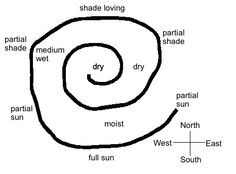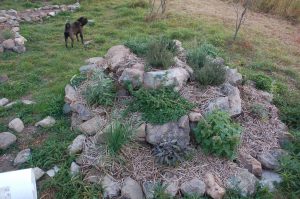What is an Herb Spiral?
The idea behind herb spirals is fairly simple: Building a circular bed with spiraled walls creates a collection of microclimates, with varying degrees of sun exposure, drainage, and the opportunity to separate bad companions and neighbor friendly plants. In a tiny space, less than six square meters, it’s possible to grow a variety of herbs that might otherwise have to be spread throughout a property. All herbs are easily accessible in a maximum of six feet diameter and 3 meter high circle. The herb spiral lets gardeners do it in one spot, where it is most needed, near to the kitchen.
This Permaculture design maximises the natural force of gravity, allowing water to drain freely and seep down through all layers – leaving a drier zone at the top (perfect for hardy herbs) and a moist area at the bottom for water lovers. The design also creates microclimates allowing you to plant a diverse range of herbs in a variety of positions (sunny, sheltered and shady). In a typical garden bed or pot, all plants are grown on the one level, so the growing conditions are the same. This design offers you multiple options in a compact space.
The stones, rocks, bricks or blocks used to build the spiral retain heat absorbed during the day and insulate the garden at night, keeping it warm when temperatures drop.
These materials form the backbone of the spiral structure which is filled with organic matter and nutrients to plant into. The spiral is watered from the top and moisture filters down to the bottom, creating different moisture zones. The bottom of the spiral can be closed off with bricks/rocks/blocks or left open to allow water to flow into a small pond or bog garden at the bottom, ideal for frogs or edible water plants that prefer a wet environment.
What are the different microclimates created?
- Top gets full sun and the soil dries more rapidly
- Bottom gets and retains the most moisture
- North side gets least direct sunlight
- South side gets the most sunlight
- East side is shielded from hot afternoon sun
- West side gets partial but intense sun
Choosing a location
First things first, permaculture design calls for developing our spaces as sensibly as possible, putting those items that require the most attention or provide the most regular use nearest to our living space. This area is called zone one. A spiral is most definitely something to put near the kitchen because herbs are a crop used daily if not multiple times a day. Breakfast, lunch and dinner can all be enhanced with herbs, so we want them close at hand. Look for a good spot near the kitchen door.
Another consideration for locating a spiral is that it’ll need sun. Most herbs like a lot of light, so be aware when putting the bed next to a wall or beneath a tree. In the same breath, having a somewhat sheltered spot, protected from the wind or heavy rains might help with the more delicate herbs. The more of these factors that can be accounted for, the more likely the plants will be successful.
Constructing an Herb Spiral
Like any structure, a spiral starts with a foundation. A two-meter diameter provides ample space to wind around a couple of times. The design works best on relatively level ground and maybe even consider layering the bottom with cardboard to prevent weeds from sprouting up in the lower levels. Atop this, lay out the spiral design with whatever material is on hand. Stones work great for spiral walls, as do reclaimed bricks, cinderblocks or bottles. The design should be a one and a half turn spiral with a clockwise turn from top to bottom (in northern hemisphere).
Next, we’ll need to fill the spiral. The obvious first ingredient is soil. A good idea here is to treat the space as if its being sheet mulched. Layer ingredients to provide weed protection, compost fertilizing, moisture retention, and airiness. After that, it’s all about the plants.
Another common feature to herb spirals in a pond near the mouth, where the spiral opens out onto the ground. This will provide a good habitat for lizards and frogs, which will help to keep the area and plants pest-free. It will also provide a space for moisture to collect to help those herbs that are into that sort of thing. And, aesthetically, it also adds a nice visual feature to the garden, with the possibility of a solar-powered fountain to provide a soothing sound for evenings on the porch, keep the water oxygenated, and maybe even house some fish.
When placing the herbs in the spiral, consider not just the individual needs of each but how they might affect the rest of the spiral. Some herbs don’t like each other. Some grow tall and might shade its neighbors. Again, the more of these factors taken into account, the better the results will be. Lastly, as always, mulch the bed.
Guidelines for Planting the Herbs
Sunny Dry (top of herb spiral – or well drained position) – bay tree (centre top position); rosemary & lavender (deep roots – centre top position); thyme; aloe vera; sage; oregano; tarragon; marjoram; garlic chives
Shady Dry (in the shadow of taller plants or under trees) – nasturtium; yarrow (light shade); parsley; thyme; oregano; sage
Sunny Moist (middle of herb spiral – or moist garden zone) – parsley, coriander/cilantro, nasturtium, sorrel, rocket/arugula, chives, spring onions; strawberries; bergamot
Shady Moist – sorrel; strawberries; chamomile; chives & arugula (partial shade); borage; parsley
Sunny Wet (bottom of herb spiral – or spot that is often wet) – mints, chamomile
Shady Wet – mints; lemon balm (light shade); cress
Aquatic (optional bottom of herb spiral if including a pond or a boggy zone) – water chestnuts, watercress and arrowhead.
Herb Planting Tips
Only plant what you plan to eat! It’s better to plant more of the herbs and vegetables you love, than to waste time and money on varieties you’re unlikely to harvest.
Consider the mature height of the plants and root systems when spacing and positioning them.
Plant established healthy seedlings in your spiral. Raise seeds to seedling stage first before planting.
Plants that require the least amount of water and require good drainage will do best in the centre of an herb spiral.
Theme your spiral garden – instead of just choosing culinary herbs for your kitchen, consider planting medicinal herbs or varieties for herb teas like peppermint, lemon balm and chamomile.
Interplant flowers among herbs to attract beneficial insects like bees.
In addition to herbs, add some easy-to-grow leafy salad greens that grow well in moist shady positions.
To maximize planting space, plant fast-growing herbs or greens like arugula, lettuce and annual flowers up close to slow growing herbs that will take time to fill out the space.
Basil enjoys full sun and moist soil. It is the crux of pesto sauce and is included in many other dishes, such as Thai curry. It’s antibacterial and anti-inflammatory, as well as promotes good cardiovascular health. Plant it mid-way up on the sunny side of the space.
Chives like the sun but can withstand a little shade. They are great sprinkled over beans, soups, omelets, and baked potatoes. Chives have cancer-preventing antioxidants and help the heart and bones. Plant them mid-way up the spiral on the east or west side of the structure.
Coriander/Cilantro digs the morning sun then cooling down in the afternoon and wants for well-drained, rich soil. It’s a must in Mexican cuisine and makes a salsa sparkle. It’s very good for the blood and has antibiotic properties. Stick it on middle rung on the sunrise side of the spiral.
Dill is another fan of morning sun with a healthy tolerance for afternoon shade and does well with a decent dose of water. It goes great with beans, anything creamy, and of course pickles. It’s a good source of calcium and helps prevent bone loss. It grows pretty tall, so place somewhere where it will not block sun for other plants.
Mint is a wildly successful and invasive, water-loving plant. It pairs well with peas, makes fantastic drinks, and produces a nice jelly. Medicinally, it’s a magical plant for battling nausea, headaches, and respiratory ailments of all sorts, including asthma. This one goes low, near the pond.
Oregano likes things on the drier, sunnier side of life. It is well-versed herb, with experience in cuisines the world over, and the health benefits of oregano are multiple in its strengthening of the immune system. Place it high on the spiral, where the water can drain and there is plenty of sun.
Parsley prefers things a bit cool, so might do well on the shadier side of the spiral. While it is usually just a garnish, it actually makes some fantastic salads and really adds a fresh punch to sauces. It freshens breath and provides important nutrients like vitamin C and iron. Put it away from the sun to keep it cooler.
Rosemary can tolerate a little cold and does best in sandy, well-draining soil. It is another classic herb for most, very strong in flavor and fantastic for roasting. It boosts memories, brightens moods, relieves pain, and improves circulation. Plant on the less sunny side of the spiral, high enough for the soil to drain.
Sage is an accommodating herb to grow, with the ability to handle diverse soil and climate. Its uses are many, including great stuffing, delicious tea, and the spiritual cleansing of spaces. It prevents chronic diseases, powers the immune system, and stimulates the brain. It likes well-drained soil and oregano, so these two would make great spiral neighbors.
Tarragon wants sunlight and dry feet. It is great for salad and salad dressings, as well as infusing vinegars, oil or butter. Great for sufferers of rheumatism or arthritis, great at stimulating the appetite, and the oil works on worms that enter the body. This another one to put high in the spiral but in the shelter of other plants.
Thyme is another herb that can take lower temperatures and sandy soil, and it can deal with a little shade as well. It’s kind of like a subdued rosemary, with a similarly evergreen taste but a little more subtlety in its flavor. The same old, same old—it helps the respiratory system, circulatory system, and prevents chronic disease. Plant it near the rosemary, give them both a little sandy soil and shade to play in.



 On our magical land, we use permaculture and biodynamic practices to consciously influence the life processes in nature so that harmonious and healing forces will be present in the medicinal herbs we grow and wild-craft.
On our magical land, we use permaculture and biodynamic practices to consciously influence the life processes in nature so that harmonious and healing forces will be present in the medicinal herbs we grow and wild-craft.